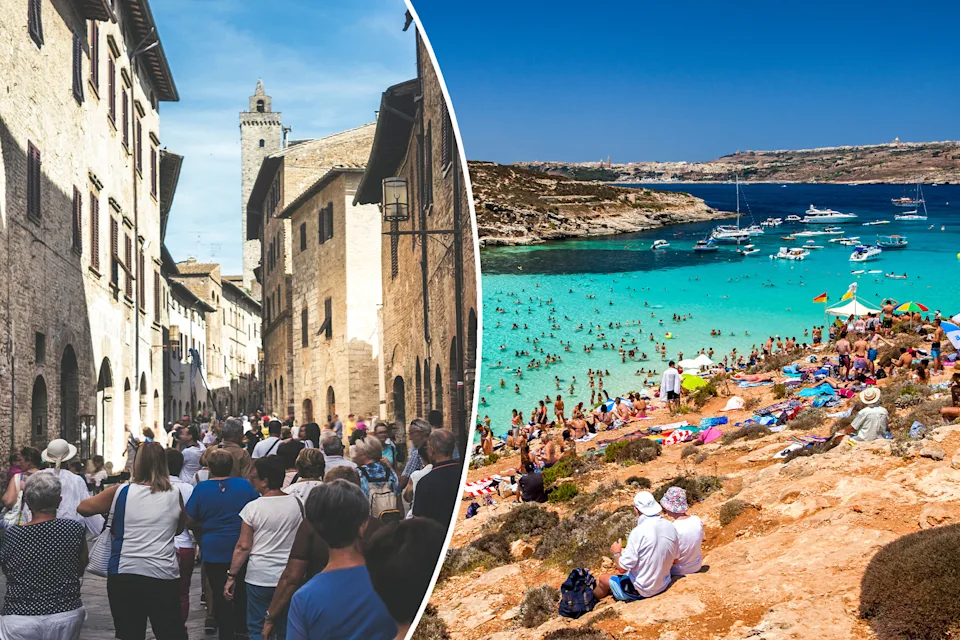When we talk about the most crowded tourist destination, it isn’t just about visitor numbers—but a tangible, bustling mass of people in a single place or over a sustained period. Let’s explore the contenders, the figures, and what makes them so overwhelming.
1. Dubai Mall, United Arab Emirates – The Reign of Retail
- In 2023, Dubai Mall reigned supreme as the world’s most visited single attraction, drawing approximately 105 million people.
- This megacomplex—home to over 1,200 stores, an aquarium, ice rink, and restaurants—is more than a mall; it’s a social and cultural hub.
Imagine tens of millions navigating this architectural behemoth in the shadow of Burj Khalifa—making it the pinnacle of consumerist tourism packed into one destination.
2. Times Square, New York City – The Urban Crossroads
- Times Square sees roughly 360,000 pedestrian visits per day, amounting to over 131 million annually.
- Even without holiday surges, its constant stream of locals and globetrotters makes it one of the most consistently crowded urban areas on Earth.
Its neon glow, billboards, and iconic status draw visitors relentlessly—defining what it means to be a landmark under siege by selfies.
3. Pilgrimage to Mecca – Spiritual Crowds Unmatched
- The Hajj pilgrimage gathers over 10.8 million Muslim pilgrims annually, many arriving during Dhu al-Hijjah.
- The Grand Mosque (Masjid al-Haram), centered on the Kaaba, can hold up to 2 million worshippers simultaneously, making it one of the densest gatherings worldwide.
This is a convergence rooted in faith, transcending tourism—yet undeniably the most concentrated human presence in a single location.
4. Bangkok – A City That Attracts Millions
- In 2024, Bangkok topped global arrival charts with 32.4 million international visitors, according to Euromonitor.
- As a transit hub and destination, Bangkok draws crowds into its streets, temples, and nightlife in staggering numbers.
Here, it’s not one point of contact but the entire urban ecosystem overwhelmed with human footfall.
5. Other Contenders: Heritage and Overwhelming Atmosphere
- Machu Picchu in Peru attracts over 1.5 million visitors annually—making it Peru’s most visited destination.
- Tourists often share how places like Kyoto, Istanbul, and Lisbon feel suffocatingly overcrowded during peak seasons, turning sightseeing into shoulder-to-shoulder navigation.
While these don’t surpass Dubai Mall or Times Square in raw numbers, they underline overtourism’s impact on cultural and heritage sites.
6. Overtourism – When Crowds Turn Toxic
The phenomenon of overtourism describes when local life and visitor experience suffer under pressure. It’s a byproduct of popularity gone unchecked, fueled in part by social media-fueled wanderlust.
Cities like Venice, Barcelona, and Amsterdam are already wrestling with congestion, housing crises, and policy backlash. For example:
- Venice is considering a steep €100/day fee for day-trippers to manage its 30-million-visitor burden.
- Barcelona grapples with Airbnb-driven displacement, as tourism strains property and community fabric.
- A recent report dubbed Paris “the most stressful city” for travelers due to an eye-watering 450,664 visitors per km²—crowding, stress, and struggle wrapped in a charming city.
- Amid such crises, experts remind us that poorly managed tourism—not tourism itself—is the real threat.
Which Destination Earns the Title?
- For sheer single-site footfall: Dubai Mall stands unrivaled with 105 million annual visits.
- For sustained urban congestion: Times Square dominates, with over 131 million pedestrian visits.
- For spiritually rooted mass gatherings: Mecca’s Grand Mosque brings millions together in a sacred, collective human experience.
Ultimately, “most crowded” depends on the lens— whether counting spiritual pilgrim density, entertainment site visitation, or everyday urban foot traffic.
Impacts, Responses, and the Way Forward
Overcrowding brings strain:
- Infrastructure creaks under pressure;
- Local culture may be marginalized;
- Environmental and social repercussions mount.
Solutions emerging include:
- Tourist taxes or fees to regulate flow,
- Visitor limits during peak periods,
- Investments in infrastructure and equitable policy,
- Promotion of off-season travel and decentralized attractions.
Conclusion
The title of “most crowded tourist destination on the planet” sits at an intersection of numbers, meaning, and context:
- Dubai Mall for relentless numbers,
- Times Square for urban relentlessness,
- Mecca for spiritual magnitude.
Each tells a story about travel’s impact—economic, cultural, and existential. As global travel rebounds, how we manage these hotspots will shape not just the visitor experience, but the destiny of the places we venerate.
